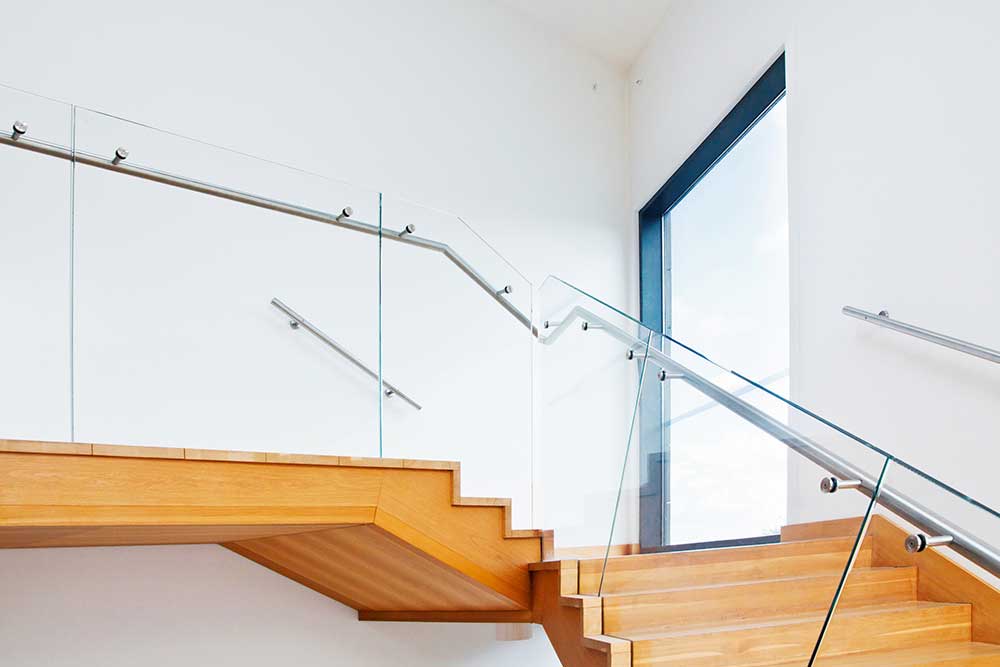Are you in the midst of choosing a handrail for your home or commercial space? Metal Handrail & Glass Handrail are two popular choices that offer a balance of safety and style. In this ultimate comparison, we’ll weigh the pros and cons of each to help you make an informed decision. Metal handrails, known for their durability, provide robust support and stability. They are ideal for high-traffic areas and can withstand heavy use without compromising safety. With various metal options such as stainless steel, wrought iron, and aluminum, you can easily find a style that complements your interior or exterior decor. On the other hand, glass handrails exude a sleek and modern aesthetic. They provide a sense of openness, allowing unobstructed views and natural light to flow through. While some may have concerns about their safety, modern glass handrails are designed with tempered glass, offering strength and resistance to impact. When it comes to safety, both metal and glass handrails can be safe choices if installed correctly and maintained properly. However, determining the safer and more stylish choice ultimately depends on your specific needs, preferences, and the overall design of your space. It’s important to consider factors such as budget, maintenance requirements, and local building codes before making a decision. Let’s dive into the details and find the perfect handrail for you.
Safety Considerations for Metal Handrails
Robustness and Reliability
Metal handrails, whether made of stainless steel, wrought iron, or aluminum, are known for their sturdy construction. This robustness allows them to provide reliable support, especially in high-traffic areas where they may experience significant usage and pressure. In outdoor installations, metal handrails offer stability and resilience against environmental elements such as wind, rain, and temperature fluctuations.
Weight-Bearing Capacity
One of the primary advantages of metal handrails is their ability to withstand considerable weight without compromising safety. This characteristic makes them suitable for supporting individuals of varying sizes and strengths, ensuring stability and security, particularly in areas prone to heavy foot traffic or where users may lean or apply pressure on the handrails.
Corrosion Resistance
While metal handrails are durable, they are susceptible to corrosion over time, especially in outdoor environments exposed to moisture and other corrosive agents. Factors such as humidity, salt air (in coastal areas), and chemical pollutants can accelerate corrosion. Therefore, it’s crucial to select corrosion-resistant materials and finishes for metal handrails, such as stainless steel with a polished or powder-coated surface, to prolong their lifespan and maintain safety standards.
Sharp Edges and Protrusions
Another safety consideration with metal handrails is the presence of sharp edges or protrusions that could cause injuries, especially in areas frequented by children or individuals with mobility impairments. Proper design and installation of handrails, including smoothing out any rough edges and ensuring secure fastening to the supporting structure, are essential to minimize the risk of accidents.
Regular Inspections and Maintenance
To uphold safety standards, regular inspections and maintenance of metal handrails are imperative. Scheduled inspections should include checks for signs of corrosion, loose fasteners or fittings, damage to the handrail structure, and any potential hazards. Prompt maintenance and repairs, such as cleaning, sanding or repainting to address corrosion, tightening loose components, and replacing worn-out parts, help mitigate safety risks and ensure the continued effectiveness of metal handrails in providing support and stability.
Safety Considerations for Glass Handrails
- Transparency and Visibility: One of the primary safety concerns with glass handrails is the potential lack of visibility, especially in environments with varying lighting conditions or distractions. While the transparency of glass enhances the overall openness and aesthetic appeal of the space, it can also make it challenging for users to perceive the presence of the handrail, increasing the risk of accidents, particularly in busy or crowded areas.
- Material Strength and Durability: To address safety concerns, tempered or laminated glass is commonly used for handrails. Tempered glass undergoes a heat treatment process that increases its strength and shatter resistance, making it less likely to break into sharp, hazardous shards upon impact. Laminated glass consists of multiple layers bonded together with an interlayer, providing additional resilience and structural integrity, even if the glass is cracked or shattered.
- Stability and Support: Incorporating top rails or handrails with additional support structures is essential for enhancing stability and preventing accidents with glass handrails. The inclusion of top rails not only offers users something to grasp onto for support but also acts as a visual indicator of the handrail’s presence, improving safety awareness and usability, particularly for individuals with visual impairments.
- Regular Cleaning and Inspection: Maintaining visibility and ensuring the structural integrity of glass handrails are crucial aspects of safety management. Regular cleaning with non-abrasive cleaners helps remove dirt, smudges, and fingerprints, ensuring optimal visibility and clarity. Moreover, scheduled inspections should be conducted to detect any signs of damage, such as cracks, chips, or loose fittings. Prompt repairs or replacements are necessary to address potential hazards and uphold safety standards.
Stylish Options for Metal Handrails
- Material Variety: Crafters can craft metal handrails from various materials, each offering unique aesthetic qualities and design possibilities. Stainless steel, prized for its modern look and corrosion resistance, is suitable for contemporary settings. Wrought iron lends a timeless elegance with its intricate detailing and classic appeal, ideal for heritage or traditional buildings. Aluminum, known for its lightweight properties and durability, offers a sleek and minimalist aesthetic that complements modern architectural designs.
- Shapes and Patterns: Fabricators can shape and form metal handrails into a myriad of configurations, allowing for creativity and customization in design. They can tailor handrails to suit the specific layout and requirements of the space, whether it’s curved, straight, spiral, or angular. Additionally, they can incorporate patterns such as scrolls, twists, or geometric motifs into the handrail design, adding visual interest and personality to the architectural element.
- Adaptability to Architectural Styles: One of the key advantages of metal handrails is their ability to seamlessly integrate with diverse architectural styles. Metal handrails can be designed to complement and enhance the overall aesthetic, whether it’s a contemporary urban setting characterized by clean lines and minimalist aesthetics or a classic heritage building adorned with ornate details and embellishments. The versatility of metal allows for flexibility in adapting to the unique character and design language of each architectural context.
- Enhanced Safety with Style: Beyond their aesthetic appeal, metal handrails prioritize safety without compromising on style. The robust construction of metal ensures structural stability and reliability, providing users with confidence and support as they navigate staircases, ramps, or elevated platforms. Additionally, the sleek and polished finishes of metal handrails contribute to a sophisticated and polished look that elevates the visual appeal of the space.
Stylish Options for Glass Handrails
- Sophistication and Openness: Glass handrails are prized for their ability to create a sense of openness and spaciousness in architectural spaces. The transparent nature of glass allows for unobstructed views, enhancing the visual flow and connectivity between different areas. This transparency also contributes to a sleek and sophisticated aesthetic that complements contemporary design themes, making glass handrails a favored choice for modern interiors and exteriors.
- Variety of Glass Types: Designers have a plethora of options when it comes to choosing the type of glass for handrail installations. Clear glass offers a timeless and minimalist look, allowing for maximum visibility and light transmission. Frosted or etched glass provides privacy while still maintaining a sense of openness, making it ideal for spaces where discretion is desired. Tinted or colored glass adds a pop of color and personality to the handrails, allowing for creative expression and customization.
- Customization with Lighting: Incorporating LED lighting into glass handrails is a popular way to enhance their visual appeal and functionality. You can seamlessly integrate LED lights into the handrail structure, creating subtle illumination that highlights the beauty of the glass and adds a touch of ambiance to the space. You can tailor lighting options to suit the design concept and mood of the environment, whether you prefer soft, diffused lighting for a calming effect or vibrant, colored lights for a dynamic atmosphere.
- Etched Designs and Patterns: Another stylish option for glass handrails is the incorporation of etched designs or patterns. Etching techniques enable crafters to etch intricate motifs, textures, or branding elements directly onto the glass surface, adding a layer of sophistication and personalization to the handrail design. Whether it’s geometric patterns, floral motifs, or corporate logos, etched designs can elevate the visual impact of glass handrails and create a distinctive focal point within the space.
Durability and Maintenance of Metal Handrails
- Durability: Renowned for their inherent durability and resistance to corrosion, stainless steel and aluminum make ideal materials for metal handrails, especially in outdoor or high-traffic environments. These metals have excellent strength-to-weight ratios, allowing them to withstand the rigors of daily use without compromising structural integrity. As a result, metal handrails can endure years of exposure to environmental factors such as moisture, temperature fluctuations, and pollutants without succumbing to deterioration.
- Low Maintenance Requirements: Metal handrails are relatively low maintenance compared to other materials, requiring minimal care to preserve their appearance and functionality. Regular cleaning with a mild detergent and water solution helps remove dirt, grime, and surface contaminants that may accumulate over time. Additionally, you should routinely inspect for signs of corrosion, damage, or loose fittings to identify any potential issues early on and address them promptly.
- Protective Coatings: Applying protective coatings to metal handrails can further enhance their durability and resistance to environmental factors. These coatings, such as powder coating or specialized paint finishes, create a barrier that shields the metal surface from moisture, UV radiation, and chemical exposure. By providing an additional layer of protection, protective coatings help prolong the lifespan of metal handrails and reduce the likelihood of corrosion or deterioration over time.
- Periodic Inspections: Regular inspections are crucial for maintaining the integrity of metal handrails and ensuring their continued effectiveness in providing safety and support. Inspections should include checks for signs of corrosion, rust, or pitting on the metal surface, as well as loose fasteners, fittings, or welds. You should address any identified issues promptly through cleaning, repair, or replacement to prevent further damage and maintain safety standards.
Durability and Maintenance of Glass Handrails
- Regular Cleaning: Maintaining the pristine appearance of glass handrails necessitates regular cleaning with non-abrasive cleaners and soft cloths. Abrasive cleaners can scratch or damage the glass surface, compromising its transparency and aesthetics. By using gentle cleaning solutions and soft materials, dirt, fingerprints, and smudges can be effectively removed without causing harm to the glass.
- Removal of Debris: In addition to routine cleaning, it’s essential to remove any debris or particles that may accumulate on the surface of glass handrails. Dust, pollen, and other airborne contaminants can settle on the glass over time, detracting from its clarity and luster. Regular dusting or wiping with a soft cloth helps prevent the buildup of debris and maintains the pristine appearance of the glass.
- Periodic Inspections: Periodic inspections are crucial for identifying and addressing potential hazards such as chips, cracks, or loose fittings in glass handrails. You should conduct these inspections regularly to detect any signs of damage or deterioration that may compromise the structural integrity of the handrails. Prompt repairs or replacements are necessary to mitigate safety risks and ensure the continued effectiveness of the glass handrails in providing support and protection.
- Professional Maintenance: In some cases, you may need to hire professional maintenance to address more complex issues or restore the appearance of glass handrails. Professional cleaning services equipped with specialized tools and techniques can effectively remove stubborn stains, hard water deposits, or other surface imperfections that may be difficult to eliminate with standard cleaning methods. Additionally, professional technicians can conduct thorough inspections and repairs to ensure the optimal performance and longevity of glass handrails.
Cost Comparison of Metal Handrail Vs Glass Handrail
Materials and Manufacturing Process:
- Metal handrails typically utilize materials such as stainless steel, aluminum, or wrought iron, which are relatively affordable and readily available. The manufacturing process for metal handrails involves cutting, shaping, and welding the metal components, which can be done efficiently and cost-effectively.
- In contrast, glass handrails require specialized materials such as tempered or laminated glass, which undergo additional processing to enhance strength and safety. The manufacturing process for glass handrails involves cutting, polishing, tempering, or laminating the glass panels, which may require more advanced equipment and expertise, thus increasing production costs.
Ease of Fabrication:
- Metal handrails are generally easier to fabricate and install compared to glass handrails. You can easily shape, weld, and assemble metal components on-site, reducing labor costs and installation time.
- Glass handrails require precise measurements and careful handling during fabrication and installation due to the fragile nature of glass. Cutting, drilling, and installing glass panels often require specialized tools and techniques, adding to the overall labor and installation costs.
Maintenance Requirements:
- Metal handrails typically have lower maintenance requirements compared to glass handrails. Basic cleaning solutions and equipment can easily clean metal surfaces, which are less prone to staining, scratching, or cracking.
- Glass handrails require regular cleaning and maintenance to preserve their clarity and appearance. Removing dirt, fingerprints, and smudges from the glass surface may require specialized cleaning products and techniques, adding to the ongoing maintenance costs over time.
Long-Term Benefits:
- While metal handrails may offer a more budget-friendly option upfront, glass handrails may provide long-term benefits in terms of aesthetics and durability. Glass handrails can enhance the visual appeal of architectural spaces and create a modern, sophisticated ambiance that may justify the higher initial investment for certain projects.
- Additionally, the durability of glass handrails, particularly those made with tempered or laminated glass, can provide peace of mind in terms of safety and longevity, potentially reducing the need for frequent repairs or replacements in the future.
Case Studies and Examples: Metal Handrails in Use:
- The renovation of a historic train station incorporated stainless steel handrails, blending modern safety features with the station’s heritage charm.
- A commercial office building opted for sleek black aluminum handrails, enhancing the contemporary design aesthetic of the workspace.
Glass Handrails in Use:
- A luxury residential project showcased floor-to-ceiling glass handrails, offering unobstructed views of the surrounding landscape while maintaining safety standards.
- A high-end retail store utilized frosted glass handrails with integrated LED lighting, creating a visually stunning ambiance for shoppers.
Conclusion
In the debate between Metal Handrail Vs Glass Handrail, both options offer distinct advantages in terms of safety, style, durability, and maintenance. While metal handrails excel in robustness and cost-effectiveness, glass handrails elevate spaces with their modern elegance and transparency. Ultimately, the choice between metal and glass handrails depends on the specific requirements, design preferences, and budget considerations of each project. Designers and homeowners can make an informed decision to ensure both safety and style are prioritized in their handrail selections by weighing the pros and cons outlined in this article.
For personalized glass solutions that exceed expectations, Glass World can be your trusted partner. Get in touch with us today to explore our extensive range and find the ideal glass products for your projects.


